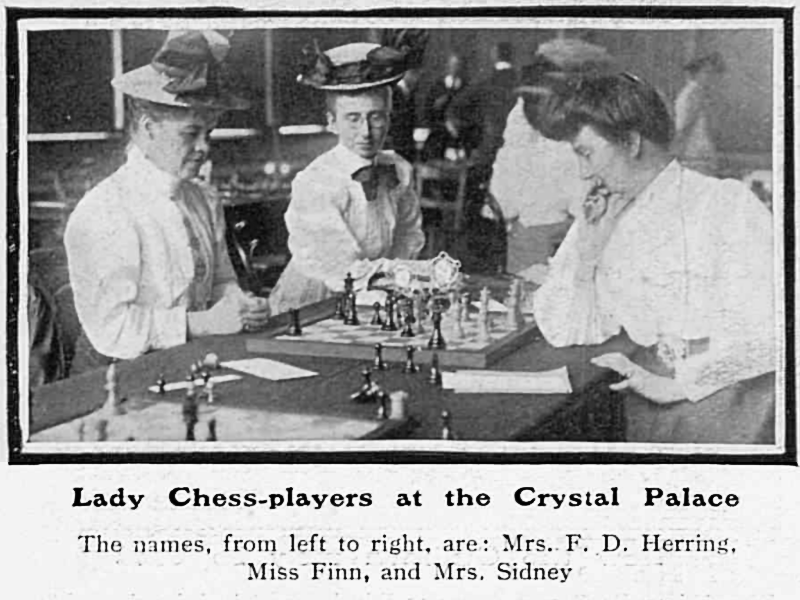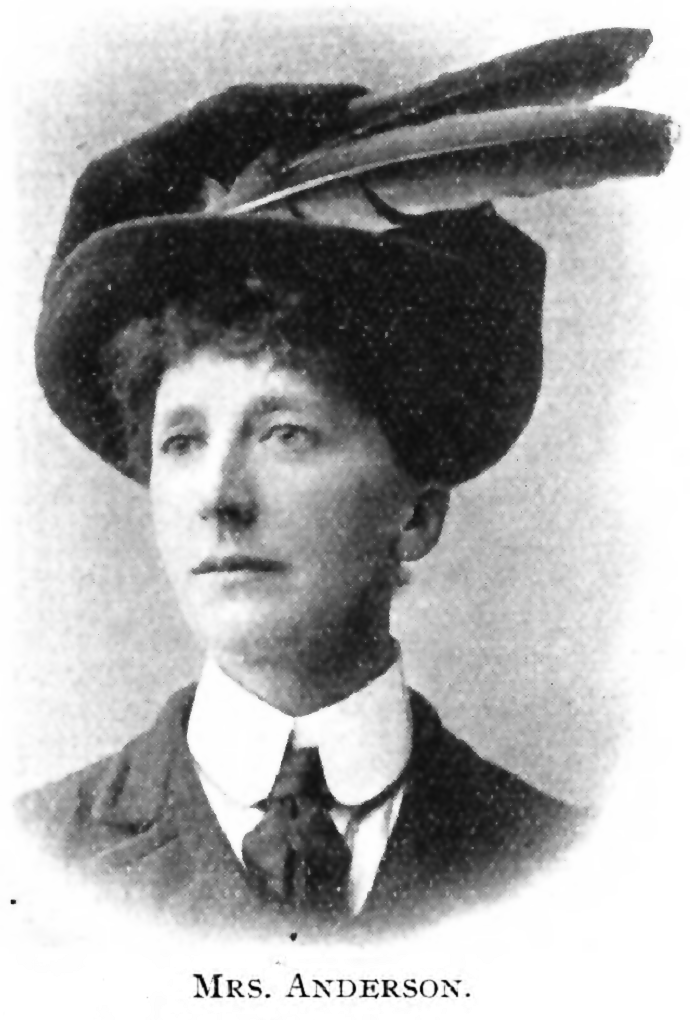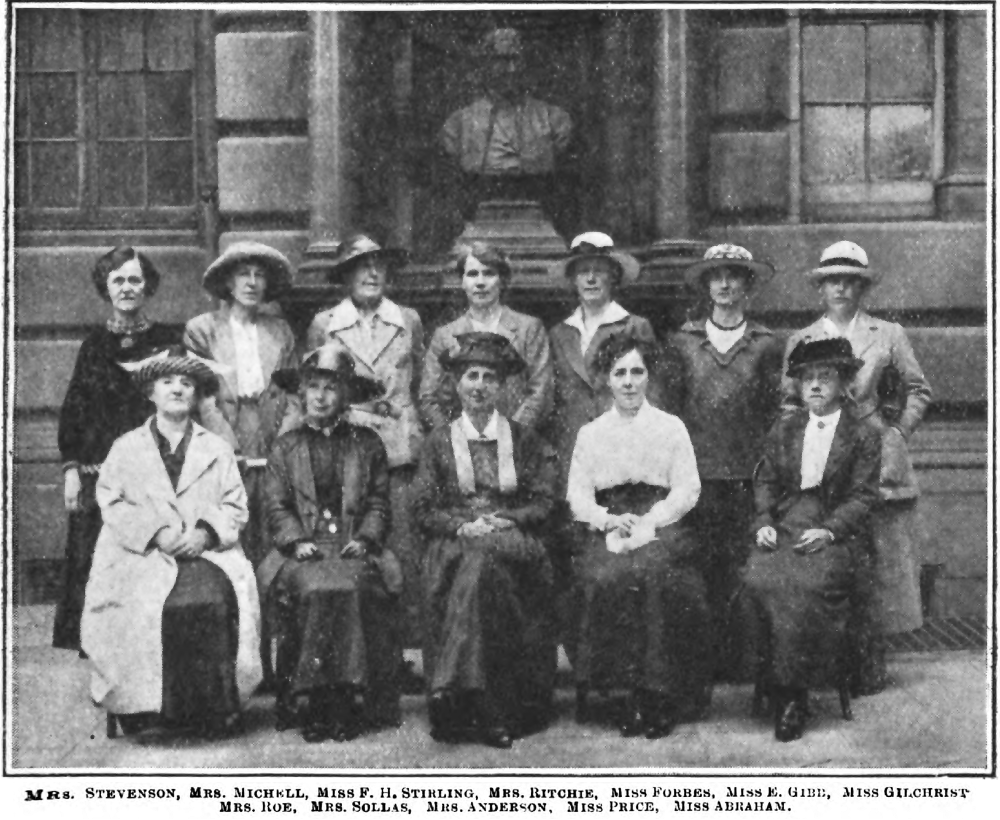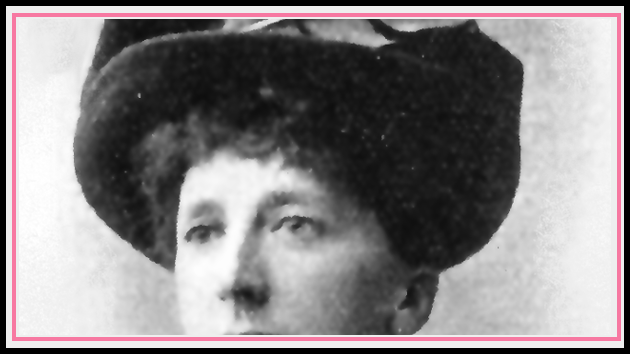
One English Lady
 St. Mary Magdalene Church in 1904
St. Mary Magdalene Church in 1904
On May 17, 1898 Gertrude Field married Donald Anderson at St. Mary Magdalene Church, Wandsworth Common, England.
Gertrude, known to her friends as Daisy (yes, Daisy Field), was 22 years old and the youngest daughter of Frederick Field (who had died in 1885), a prominent and successful practical chemist, a professor of chemistry at St. Mary's Hospital and a Fellow of the Royal Society.
The bride was a member of the Ladies Chess Club of London (founded in 1895) while the groom belonged to the British Chess Club.
During those years of chess female players were usually wives of chess playing husbands and only learned the game or attained more than passingly interested in it during their marriage. This was not the case with Daisy Field. It could even be that a mutual interest in chess drew the two lovers together since Donald Loveridge Anderson was known to be a strong club player as well as a problem composer and Gertrude Alison Beatrice Field had earned 2nd place in the ladies' major tournament at Hastings in 1895 (right behind Lady Edith Thomas).
A few days before their wedding, Gertrude was given a wedding present of a silver sugar basin with tongs during an "at home" chess soirée, accentuating their blend of chess and marriage.
 Miss Field 1897
Miss Field 1897
(most images here may be viewed in full size by clicking on the image)
Miss Field lost the following game to Mary Rudge (considered by many to have been the finest women player of the day). This game is from the first Ladies' International Tournament of 1897 (the tournament won convincingly by Mary Rudge). :
Donald Anderson, also playing Black in an Italian Game (Evans Gambit) in 1898, won this hard-fought clever game.
According to Rhoda A. Bowles (founder of the Ladies' C.C. and wife of Henry Lewis Bowles, a very strong member of the City of London, the Metropolitan and the London Polytechnic chess clubs), Mrs. Anderson was considered an excellent portrait painter, so much so that Mrs. Bowles had own portrait by Mrs. Anderson hanging in her drawing room. Anderson's obituary mentions her ability as an author. At any rate she not only seemed to have been a woman of many talents, but notably personable besides. Mrs. Bowles described her as "bright and vivacious, infusing life where ever she goes." The author of her obituary wrote, "in private life she was a very charming lady." Donald and Gertrude had one child, a son, Basil William Anderson, born in 1901.
Around the turn of the century, Mrs. Anderson's chess accomplishments at that point exceeded that of most of her contemporaries, but for her, it was just a first step in her chess trek. Between 1904 (when the first sanctioned British Ladies Championship took place) and her death on Sept. 6, 1924, just a month shy of her 49th birthday, Gertrude Anderson had taken part in the majority of British Ladies Championships, winning the title 3 times: 1909, 1912 and 1921.
Mrs. Anderson, besides winning the championship three times, managed to come in second (or to tie for second) a number of times. I hope to look at the British Ladies Championships from its start in 1904 until Mrs. Anderson's final participation in 1921 when she went out a winner.
1904 saw Kate Finn win the title for her first time. She didn't just burst into the forefront out of nowhere. Miss Finn had been recognized as a strong player for a years. Six years earlier, in January 1898, the Birmingham Gazette was quoted in the American Chess Magazine saying, "Miss Finn has won golden opinions as a chessplayer, as well as in every other way. She is always a strong player, but in pink is simply irresistible."
Catherine Belinda Finn was from Cork, Ireland where her father, Eugene, practiced medicine. After his death in 1885, Kate and her mother, Belinda, moved to London. Kate was taught the moves and rules of chess by her mother in 1891 when she was already 27 years old. Most of her real chess learning occurred as a member of the Ladies Chess Club of London which was formed in 1895. By 1897 she was winning first prizes at various club tournaments. She also played for the Kent County Association and in some international tournaments later on in her life.
Note that Mrs. Herring and Mrs. Anderson tied for second place.
1904
Hastings

Miss Finn repeated her feat in 1905. However Mrs. Anderson edged out Mrs. Herring for second place.
1905
Southport

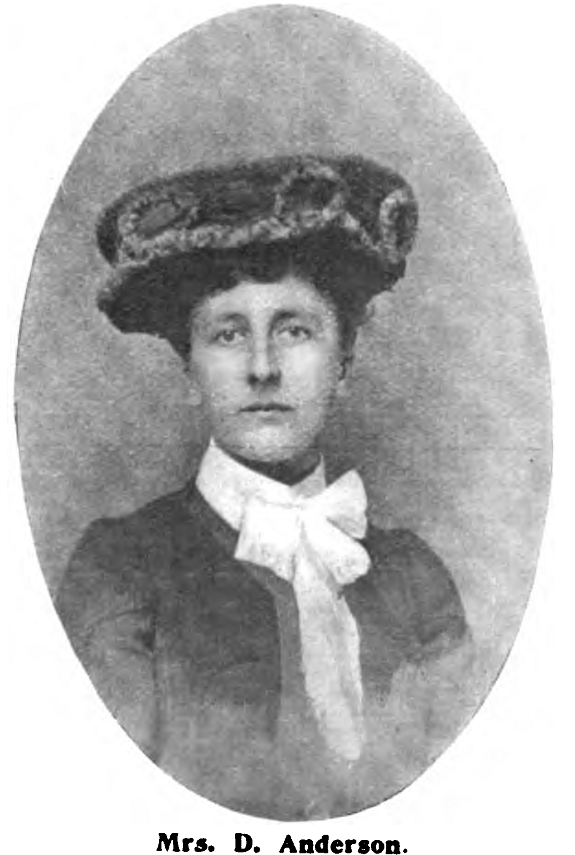 from Rhoda Bowles' Womanhood chess column in 1905
from Rhoda Bowles' Womanhood chess column in 1905
In a stroke of luck for her opponents, Miss Finn was indisposed (caring for her sick mother) couldn't participate in 1906. Mrs. Herring outplayed Mrs. Anderson winning first place by a half point.
Although Miss Finn would continue playing competitive chess, she wouldn't take part in anymore British Ladies Championships.
1906
Shrewsbury

1907 shows Mrs. Herring and Mrs. Houlding sharing first, leaving poor Mrs. Anderson again in second place by a half point. The actual progression of events was a bit more intense. Mrs. Herring led the field until the 8th round when Mrs. Anderson took the lead. In the last three rounds, Mrs. Houlding defeated both Mrs. Herring and Mrs. Anderson as well as Mrs. Bowles. This left Anderson in the dust and Herring needing a win in the last round just to tie. A later playoff, however, allowed Mrs. Herring to once again secure the title and the trophy.
1907
Crystal Palace

Played at the Crystal Palace in London, the first prize was £10; second, £7 10s.; third, £5; fourth, £2 10s. Additionally, the first prize winner received a gold medal and hold the British Ladies' Championship trophy and title of British Lady Champion for one year.
1908 was quite a fascinating tournament. Agnes Lawson, who only came in 5th the previous year, led throughout the contest until the last rounds when she lost to both Gertrude Anderson and Grace Curling (Grace Curling was Grace Moore Ellis who had played in the 1904 championship, having married Allen Lee Curling on Nov. 2, 1906), leaving them in a three-way tie for first. Frances Herring who had won the two previous years was surprisingly pushed into 4th place. Although they evenly split the sum of the first three prizes, a playoff on the following February determined the title and the trophy winner. Grace Curling won the playoff with 2½ pts. Agnes Lawson followed with 2 pts. while Gertrude Anderson uncharacteristically trailed with1½ pts. Grace Curling would later become a champion dahlia cultivator also.
1908
Tunbridge Wells
1909
Glasgow, Scotland
1909 was Mrs. Anderson's time to shine.
 The trophy, presented to the Federation in 1904 by Capt. A.S. Beaumont of London (and president of the Surry County Chess Association) and valued at the time at twenty-five guineas, was a silver rose bowl decorated with ornaments symbolical of chess.
The trophy, presented to the Federation in 1904 by Capt. A.S. Beaumont of London (and president of the Surry County Chess Association) and valued at the time at twenty-five guineas, was a silver rose bowl decorated with ornaments symbolical of chess.
The British Chess Magazine published the above photo with the following text:
Mrs. Gertrude A. Anderson, the new lady champion, was born in an old-fashioned country house at Hither Green, Kent. She learnt to play chess when about nine years old, but did not have much practice until five years later. After this she enjoyed much travelling on the Continent and used to challenge any chess players she met in the hotels of Germany and Switzerland.
In 1895 Mrs. Anderson joined the London Ladies' Chess Club, and ten years later, in 1905, and also in 1906, she won the club championship tournament ; but her first appearance in connection with public chess was in a tournament at the Hastings International Congress of 1895, when she won second prize.
Mrs. Anderson has competed in all the championship tournaments promoted by the British Chess Federation, and has always reached a high place in the final score sheet, but has never previously secured premier honours. Her record, previous to the present contest is appended: ——1904, equal second ; 1905, equal second ; 1906, second ; 1907, third ; 1908, equal first. Her record in each of the last four contests has been 8½ pts. These figures are excellent testimony that Mrs. Anderson plays a sound thoughtful game, and we are sure that we voice the sentiments of all her fellow-competitors in saying that her success at Scarborough gave general pleasure. Her talents as a player are not confines to vis-à-vis encounters. She can play two blindfold games very comfortably and is always glad on an opponent for a bout of chess sans voir.
In forwarding, at our request, her portrait for reproduction in the B.C.M., Mrs. Anderson says ;—— "I always enjoy the Federation Congresses immensely l they go smoothly, and the players are all so nice that it is a pleasure to play against them. You scarcely ever find a bad loser nowadays, at any rate not amongst the ladies."
Contrary to the BCM article above, Mrs. Anderson, even before her marriage (when she was Miss Field) was capable of playing four simultaneous blindfold games successfully [as well as being the first woman on record for bind simuls --batgirl]. On Oct. 21, 1895 the newly established Ladies' Chess club of London inaugurated their new headquarters by presenting both a blindfold and a simultaneous performances. Mrs. Bowled wrote:
"Miss Field was the blindfold performer, and Lady Thomas gave the exhibition of simultaneous chess. Miss Field had four opponents, and her play was fairly good, but unfortunately time did not allow of any of the games being completed. Lady Thomas' performance was also a great success. There was a large gathering, presided over by Lady Newnes, and the proceedings commenced with a musical programme."
1910 was another surprising contest. Mrs. Lawson led the pack the entire event and going into the last round led Mrs. Houlding 8½ to 8. As fate would have it the final game pitted Lawson and Houlding. Lawson, only needing a draw, played with unnecessary aggression and lost. Mrs. Anderson picked up 3rd prize.
1910
Oxford

1911 felt the absence of both Mrs. Anderson and Mrs. Herring. Although this event, being played in Glasgow, included the Scottish Ladies Champion, Mrs. Hutchison-Sterling. Mrs. Houlding, after a seemingly unredeemable start, finished a full point ahead of second place Mrs. Moseley.
1911
Glasgow, Scotland

Gertrude Anderson returned with a vengeance in 1912, losing only one game. Mrs. Edith Price, who was the manageress of the famous chess café, The Gambit, entered the fray for the first time (she would win the title five times, the last time at age 76) and offered the greatest resistance.
1912
Richmond
Mrs. Anderson didn't participate in the 1913 and 1914 championships (participants and results below), then during the war years, 1915-16-17-18, the championship was suspended.
1913
Cheltenham

A word about Mrs. R.H.S.Stevenson. This was Agnes Lawson. She had married Rufus Henry Streatfeild Stevenson, also a chess player/organizer in 1912. Poor Agnes met a untimely and gruesome death in 1935 when she carelessly walked into a spinning airplane propeller. In 1937 her husband married Vera Menchik. Mr. Stevenson died in 1943, while Vera Menchik died in 1944.
1914
Chester
When the championship resumed after WWI, Mrs. Anderson once again became engaged in the game. 1919 shows her sharing second place with Mrs. A. S. Roe. Fifty-year-old Edith Holloway, who had taken part in the 1913 and 1914 events, walked away with the title with a 2 pt. lead, perhaps partly due to the fact that Edith Price, who had contracted sunstroke, forfeited her last six games. Mrs. Holloway was married to Samuel John Holloway, also a chess player, of course, but in this case the weaker of the two although he was considered a good chess promoter.
1919
Hastings
In 1920 Mrs. Anderson yet again falls behind Edith Price and Agnes (Lawson) Stevenson who shared 1st-2nd place.
1920
Edinburgh, Scotland
Mrs. Stevenson won the two-game playoff later in the year beating Miss Price 2-0.
1921
Malvern
In 1908 Mrs. Anderson had been involved in a 3-way tie involving Mrs. Curling (formerly Miss Ellis) and Miss Lawson (later Mrs. Stevenson). 1921 turned in to an eerie reenactment with Mrs. Anderson tying with Mrs. Mitchell and Miss Price. As was the case with most ladies' championships, nothing could be taken for granted and upsets ruled the day. Miss Hutchinson-Sterling, who had an early substantial lead, fell by the wayside while Mrs. Stevenson, Mrs. Anderson and Mrs. Price (who had a bad start), kept up a steady pressure. Mrs. Michell started wavering and Mrs. Price made up for lost time. In the last rounds Mrs. Michell finally regained her composure, Mrs. Price finished her comeback and Mrs. Anderson beat the early leader, Miss Hutchinson-Sterling... leaving them with 8 pts. each.
Mrs. Rawson invited the three to a playoff at the Imperial Chess Club (played in September).
There were several pictures published from the playoff:
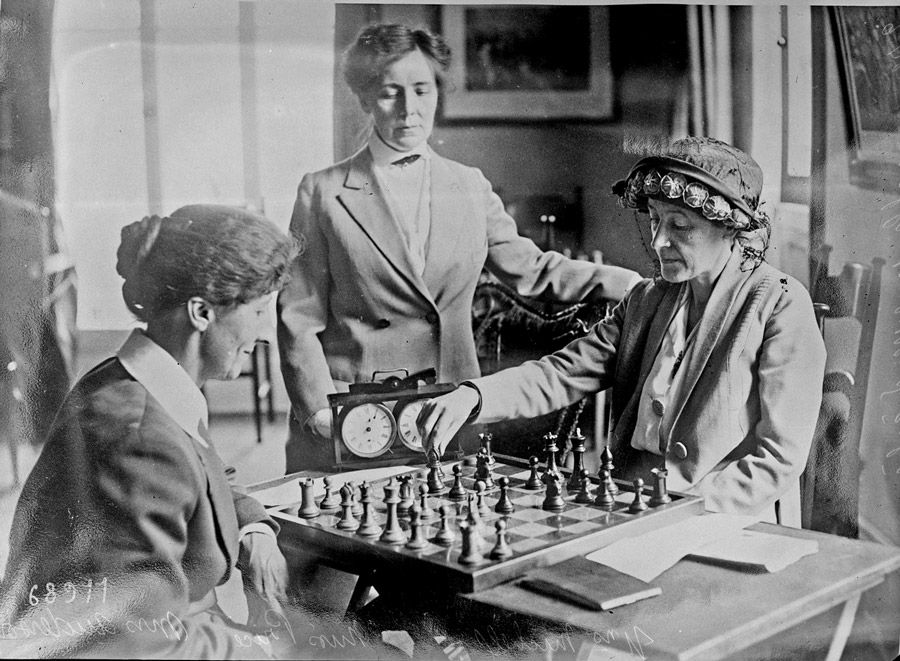 L-R: Edith Michell, Edith Price, Gertrude Anderson
L-R: Edith Michell, Edith Price, Gertrude Anderson
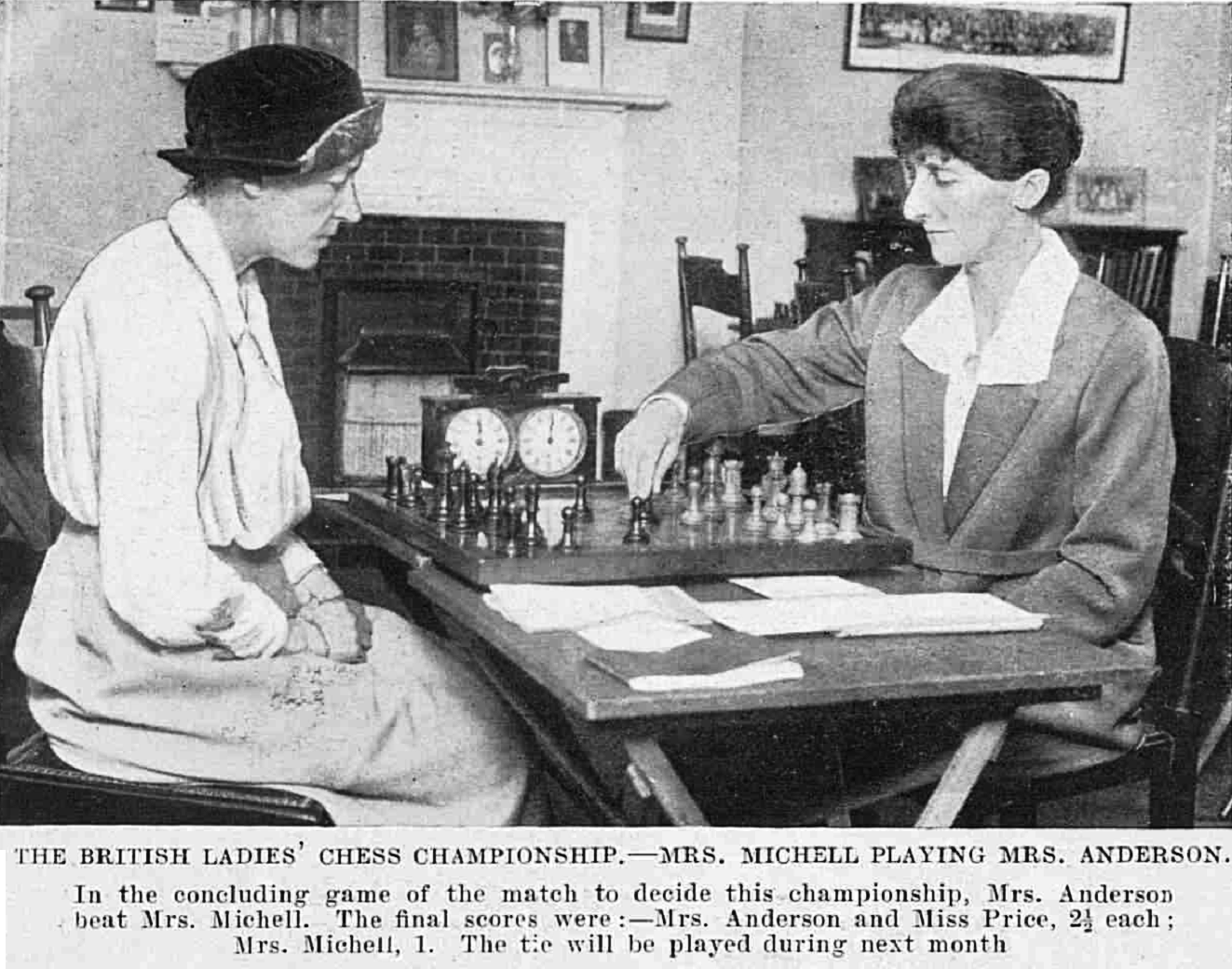 published in the Illustrated Sporting and Dramatic News, Sept. 24, 1921
published in the Illustrated Sporting and Dramatic News, Sept. 24, 1921
The blurb in the above photo shows the result of the first leg in the tie break which was played at the Imperial Chess Club, Sept. 12-18 and required a second tie-break
The games went as follows: Price-Anderson 1-0 ; Price-Michell 1-0 ; Michell-Anderson ½-½ ; Anderson-Price 1-0 ; Michell-Price-½-½ ; Anderson-Michell 1-0.
Anderson 2½ pts. ; Price 2½ pts. ; Michell 1 pt.
Edith Michell (here, about 50), who had been playing in every championship since 1912, was married to Reginald Price Michell, another very strong English player. Mrs. Michell would later, while in her sixties, become a 3-time title winner.
Game 1
game 6
The second tie break would take place starting Oct. 11 also as the Imperial Chess Club.
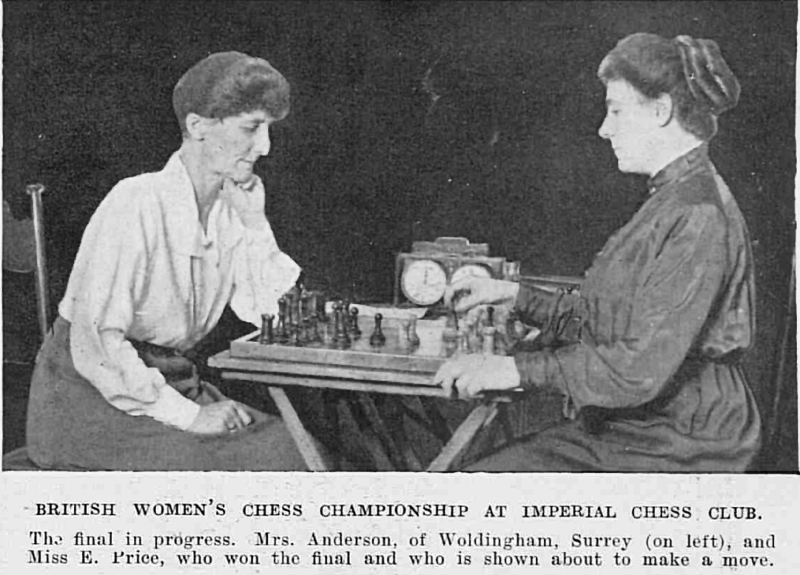 published in the Illustrated Sporting and Dramatic News, Oct. 22, 1921
published in the Illustrated Sporting and Dramatic News, Oct. 22, 1921
The above photo was taken during the 2nd tie break match. The results of which were (the caption is wrong):
Oct. 11 Price-Anderson 1-0
Oct. 18 Anderson-Price 1-0
Oct. ?? Anderson-Price 1-0
. . . giving Gertrude Anderson her third title.
The last mention I could find of Mrs. Anderson regarding public chess was when she, along with three other ladies, was recognized as a participant in the famous International Chess Congress at the Central Hall in Westminster, 1922.
published in The Graphic, Aug. 19, 1922
Gertrude Alison Beatrice Field Anderson died on Sept. 6, 1924 published in The Hull Daily Mail, Sept. 10, 1924
published in The Hull Daily Mail, Sept. 10, 1924 published in the British Chess Magazine, Oct. 1924
published in the British Chess Magazine, Oct. 1924
Her husband, Donald, lived until April, 1947 and her son, Basil until February 1984.
